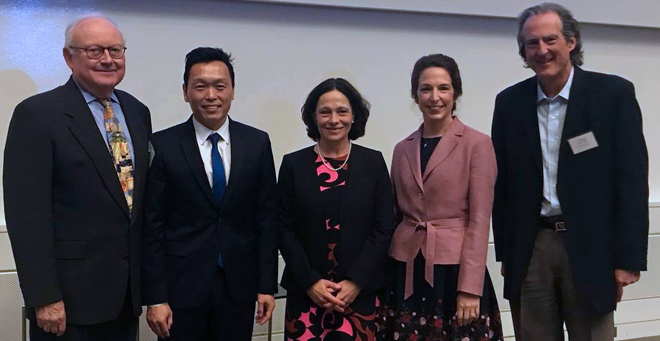 |
|
|
Left to right are Thoru Pederson, Jason Kim, Silvia Corvera, Tiffany Moore Simas and Craig Mello. |
The 33rd Annual Meeting of the Hudson Hoagland Society convened to discuss one of the most interesting questions in health research today: What makes some adipose tissue—commonly called “fat”—good and other fats bad?
Silvia Corvera, MD, the Endowed Chair in Diabetes Research and professor of molecular medicine; Tiffany Moore Simas, MD, MPH, MEd, associate professor of obstetrics & gynecology, psychiatry and quantitative health sciences; and Jason Kim, PhD, professor of molecular medicine and medicine and the director of the UMMS National Mouse Metabolic Phenotyping Center, served as panelists. They were introduced by Thoru Pederson, PhD, the Vitold Arnett Professor of Cell Biology, professor of biochemistry & molecular pharmacology, and associate vice provost for research.
Each panelist approached the question of how fat works with a “surprising story of the lives within our bodies,” as the program described the evening, all linked by the growing awareness that fat cells are active players not just in obesity, but in metabolism, pregnancy and even the gut bacteria that help organisms turn food into energy.
Dr. Corvera described a laboratory method to generate new human fat cells in a culture dish from pluripotent stem cells living in fat tissue.
“This is a really exciting technology and laboratory tool, helping us understand how fat cells work,” she said. “We can, for example, treat white fat cells in culture and turn them into higher metabolizing ‘beige’ fat cells, which we know can improve glucose utilization. So the question is: Will we be able to use these beige cells in humans to treat metabolic disorders like diabetes?”
Beige fat cells fall between the white fat cells that expand with weight gain and the very high metabolizing brown fat cells, which serve a number of important health purposes, including helping newborn babies stay warm and hibernating animals survive the winter.
Dr. Moore Simas described the discovery of “a novel ‘conversation’ happening during pregnancy, when growth factors from the placenta promote healthy adipose tissue growth, which is associated with a decrease in risk for gestational diabetes.”
But something else happens in gestational diabetes—the onset of high blood sugar levels in a pregnant woman that increases the risk of, among other health threats, Caesarean delivery.
“Gestational diabetes develops in pregnancy; it often goes away, but about half of all women who have it eventually develop adult-onset diabetes later in life,” said Moore Simas. “Key questions about gestational diabetes have to do with weight gain in pregnancy, which is absolutely necessary for a healthy baby, but also has consequences for the mother. Weight gain, which expands adipose tissue, leads to higher rates of Caesarean deliveries, high blood pressure and incidence of gestational diabetes. Or to put it another way, what is the role of adipose tissue in pregnancy? Is the ability of adipose tissue to expand actually enhanced during pregnancy and is it enhanced in gestational diabetes?”
The answer is yes; healthy women, when they gain weight during pregnancy, expand the amount of fat tissue they have, she said. This led to the identification of the surprising interplay between growth factors in the placenta and the expansion of adipose tissue.
Dr. Kim talked about the surprising relationship between obesity and antibiotic use, leading researchers to look at the gut microbiome to help explain obesity, especially how the diversity in the microbiome is essential to health and a decline in microbiome diversity from antibiotic use, particularly in children under age 3, when the gut microbiome is developing.
Pederson announced the six recipients of the Worcester Foundation for Biomedical Research grant program. Both Kim and Moore Simas were previous recipients of WFBR grants. This year’s recipients are:
Alexandra Byrne, PhD, assistant professor of neurobiology, for “Mechanisms of axon regeneration: moving beyond regrowth;”
Charles Emerson Jr., PhD, professor of neurology and director of the UMMS Wellstone Institute, for “Fixing disease genes by giving them a break;”
Katherine Fitzgerald, PhD, professor of medicine, for “Repurposing of ibutilide fumarate for the treatment of inflammatory disease;”
Haijiang Lin, MD, PhD, assistant professor of ophthalmology & visual sciences and recipient of the Bassick Family Foundation Award, for “Cytosolic accumulation of nuclear DNA fragments in RPE cells and neovascular age-related macular degeneration;”
Oliver Rando, MD, PhD, professor of biochemistry & molecular pharmacology, for “Molecular trafficking from the brain to the male reproductive tract;” and,
Leslie Shaw, PhD, associate professor of molecular, cell & cancer biology and recipient of the Joan and Robert Bernhard Foundation Award, for “Solving IRS structure to target the insulin/IGF-1 signaling pathway in cancer.”